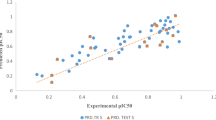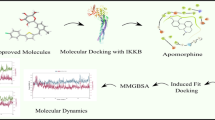Abstract
Alzheimer’s disease (AD) is a chronic intensifying neurodegenerative disorder and accounts for three fourths of dementia cases. To date, there is no effective treatment available which can completely cure AD. The available medications can slower AD progression and can provide symptomatic relaxation. The N-methyl-d-aspartate receptor (NMDAR) plays a paramount role in the survival of neurons and synaptic plasticity. It is also involved in several other diseases. Although, excessive function of NMDAR cause excitotoxicity. Due to this the cell death process activated resulting into neurodegeneration and promotes AD. Hence in this study, we have screened 98,072 natural compounds using Smina and idock. After that top scoring 154 compounds were selected and ADMET analysis was carried out. It reveals that 18 compounds are good fit in all the ADMET parameters and employed for the re-docking studies using Autodock Vina. Then from the docking result, we have selected top three complexes (NMDAR-ZINC4258884, NMDAR-ZINC8635472, and NMDAR-ZINC15675934) and employed them for the 100 ns MDS studies. Based on MDS and Gibbs free energy landscape result analysis we have concluded that NMDAR-ZINC4258884 and NMDAR-ZINC15675934 are the best stable complex and can function as a lead compound against the NMDAR. Although this is a theoretical study while we have shortlisted only two compounds out of 98,072 compounds using rigorous computational approach and proposed them to the scientific community worldwide for further experimental validations.








Similar content being viewed by others
References
Abbott JJ, Howlett DR, Francis PT, Williams RJ (2008) Abeta(1–42) modulation of Akt phosphorylation via alpha7 nAChR and NMDA receptors. Neurobiol Aging 29:992–1001. https://doi.org/10.1016/j.neurobiolaging.2007.01.003
Abraham MJ, Murtola T, Schulz R et al (2015) GROMACS: high performance molecular simulations through multi-level parallelism from laptops to supercomputers. SoftwareX 1–2:19–25. https://doi.org/10.1016/j.softx.2015.06.001
Ajjarapu SM, Tiwari A, Taj G et al (2021) Simulation studies, 3D QSAR and molecular docking on a point mutation of protein kinase B with flavonoids targeting ovarian Cancer. BMC Pharmacol Toxicol 22:1–23. https://doi.org/10.1186/s40360-021-00512-y
Armstrong N, Gouaux E (2000) Mechanisms for activation and antagonism of an AMPA-sensitive glutamate receptor: crystal structures of the GluR2 ligand binding core. Neuron 28:165–181. https://doi.org/10.1016/s0896-6273(00)00094-5
Bera K (2021) Binding and inhibitory effect of ravidasvir on 3CLpro of SARS-CoV-2: a molecular docking, molecular dynamics and MM/PBSA approach. J Biomol Struct Dyn 0:1–8. https://doi.org/10.1080/07391102.2021.1896388
Bera K, Rani P, Kishor G et al (2018) Structural elucidation of transmembrane domain zero (TMD0) of EcdL: a multidrug resistance-associated protein (MRP) family of ATP-binding cassette transporter protein revealed by atomistic simulation. J Biomol Struct Dyn 36:2938–2950. https://doi.org/10.1080/07391102.2017.1372311
Bera K, Reeda VSJ, Babila PR et al (2021) An in silico molecular dynamics simulation study on the inhibitors of SARS-CoV-2 proteases (3CLpro and PLpro) to combat COVID-19. Mol Simul 47:1168–1184. https://doi.org/10.1080/08927022.2021.1957884
Blanke ML, Van Dongen AMJ (2009) Activation mechanisms of the NMDA receptor. In: Van Dongen AM (ed) Biology of the NMDA receptor. CRC Press/Taylor & Francis, Boca Raton
Cao J, Hou J, Ping J, Cai D (2018) Advances in developing novel therapeutic strategies for Alzheimer’s disease. Mol Neurodegener 13:64. https://doi.org/10.1186/s13024-018-0299-8
Companys-Alemany J, Turcu AL, Bellver-Sanchis A et al (2020) A novel NMDA receptor antagonist protects against cognitive decline presented by senescent mice. Pharmaceutics 12:E284. https://doi.org/10.3390/pharmaceutics12030284
Danysz W, Parsons CG (2012) Alzheimer’s disease, β-amyloid, glutamate, NMDA receptors and memantine–searching for the connections. Br J Pharmacol 167:324–352. https://doi.org/10.1111/j.1476-5381.2012.02057.x
Darden T, York D, Pedersen L (1993) Particle mesh Ewald: an N⋅log(N) method for Ewald sums in large systems. J Chem Phys 98:10089–10092. https://doi.org/10.1063/1.464397
Folch J, Petrov D, Ettcheto M et al (2016) Current research therapeutic strategies for Alzheimer’s disease treatment. Neural Plast 2016:8501693. https://doi.org/10.1155/2016/8501693
Gece G, Bilgiç S (2009) Quantum chemical study of some cyclic nitrogen compounds as corrosion inhibitors of steel in NaCl media. Corros Sci 51:1876–1878. https://doi.org/10.1016/j.corsci.2009.04.003
Genc ZK, Tekin S, Sandal S et al (2015) Synthesis and DFT studies of structural and some spectral parameters of nickel(II) complex with 2-(2-hydroxybenzoyl)-N-(1-adamantyl) hydrazine carbothioamide. Res Chem Intermed 41:4477–4488. https://doi.org/10.1007/s11164-014-1545-5
Hess B, Bekker H, Berendsen HJC, Fraaije JGEM (1997) LINCS: a linear constraint solver for molecular simulations. J Comput Chem 18:1463–1472. https://doi.org/10.1002/(SICI)1096-987X(199709)18:12%3c1463::AID-JCC4%3e3.0.CO;2-H
Ikonomidou C, Turski L (2002) Why did NMDA receptor antagonists fail clinical trials for stroke and traumatic brain injury? Lancet Neurol 1:383–386. https://doi.org/10.1016/s1474-4422(02)00164-3
Jewett BE, Thapa B (2021) Physiology, NMDA receptor. In: StatPearls. StatPearls Publishing, Treasure Island
Johnson ER, Yang W, Davidson ER (2010) Spin-state splittings, highest-occupied-molecular-orbital and lowest-unoccupied-molecular-orbital energies, and chemical hardness. J Chem Phys 133:164107. https://doi.org/10.1063/1.3497190
Kato T, Duman RS (2020) Rapastinel, a novel glutamatergic agent with ketamine-like antidepressant actions: convergent mechanisms. Pharmacol Biochem Behav 188:172827. https://doi.org/10.1016/j.pbb.2019.172827
Kumar A, Nisha CM, Silakari C et al (2016) Current and novel therapeutic molecules and targets in Alzheimer’s disease. J Formos Med Assoc 115:3–10. https://doi.org/10.1016/j.jfma.2015.04.001
Li H, Leung K, Wong M (2012) idock: a multithreaded virtual screening tool for flexible ligand docking. In: 2012 IEEE Symposium on Computational Intelligence in Bioinformatics and Computational Biology (CIBCB), pp 77–84
Lindorff-Larsen K, Piana S, Palmo K et al (2010) Improved side-chain torsion potentials for the Amber ff99SB protein force field. Proteins 78:1950–1958. https://doi.org/10.1002/prot.22711
Liu J, Chang L, Song Y et al (2019) The role of NMDA receptors in Alzheimer’s disease. Front Neurosci. https://doi.org/10.3389/fnins.2019.00043
Lu Y, Wang Y, Zhu W (2010) Nonbonding interactions of organic halogens in biological systems: implications for drug discovery and biomolecular design. Phys Chem Chem Phys 12:4543–4551. https://doi.org/10.1039/B926326H
Matysiak J (2007) Evaluation of electronic, lipophilic and membrane affinity effects on antiproliferative activity of 5-substituted-2-(2,4-dihydroxyphenyl)-1,3,4-thiadiazoles against various human cancer cells. Eur J Med Chem 42:940–947. https://doi.org/10.1016/j.ejmech.2006.12.033
Morel V, Joly D, Villatte C et al (2018) Preventive effect of oral magnesium in postmastectomy pain: protocol for a randomised, double-blind, controlled clinical trial. BMJ Open 8:e017986. https://doi.org/10.1136/bmjopen-2017-017986
Morris GM, Huey R, Lindstrom W et al (2009) AutoDock4 and AutoDockTools4: automated docking with selective receptor flexibility. J Comput Chem 30:2785–2791. https://doi.org/10.1002/jcc.21256
Newcomer JW, Farber NB, Olney JW (2000) NMDA receptor function, memory, and brain aging. Dialogues Clin Neurosci 2:219–232
Pathak RK, Lim B, Park Y, Kim J-M (2022a) Unraveling structural and conformational dynamics of DGAT1 missense nsSNPs in dairy cattle. Sci Rep 12:4873. https://doi.org/10.1038/s41598-022-08833-6
Pathak RK, Seo Y-J, Kim J-M (2022b) Structural insights into inhibition of PRRSV Nsp4 revealed by structure-based virtual screening, molecular dynamics, and MM-PBSA studies. J Biol Eng 16:4. https://doi.org/10.1186/s13036-022-00284-x
Pettersen EF, Goddard TD, Huang CC et al (2004) UCSF Chimera—a visualization system for exploratory research and analysis. J Comput Chem 25:1605–1612. https://doi.org/10.1002/jcc.20084
Pires DEV, Blundell TL, Ascher DB (2015) pkCSM: predicting small-molecule pharmacokinetic and toxicity properties using graph-based signatures. J Med Chem 58:4066–4072. https://doi.org/10.1021/acs.jmedchem.5b00104
Rajendran V, Shukla R, Shukla H, Tripathi T (2018) Structure-function studies of the asparaginyl-tRNA synthetase from Fasciola gigantica: understanding the role of catalytic and non-catalytic domains. Biochem J 475:3377–3391. https://doi.org/10.1042/BCJ20180700
Rajendran V, Kandasamy S, Gupta A, et al (2020) Insilico identification of potential antivirals and molecular dynamics against SARS-CoV2 main protease and RBD of spike protein. https://doi.org/10.26434/chemrxiv.13181117.v1
Ryckaert J-P, Ciccotti G, Berendsen HJC (1977) Numerical integration of the cartesian equations of motion of a system with constraints: molecular dynamics of n-alkanes. J Comput Phys 23:327–341. https://doi.org/10.1016/0021-9991(77)90098-5
Shukla R, Singh TR (2020a) Virtual screening, pharmacokinetics, molecular dynamics and binding free energy analysis for small natural molecules against cyclin-dependent kinase 5 for Alzheimer’s disease. J Biomol Struct Dyn 38:248–262. https://doi.org/10.1080/07391102.2019.1571947
Shukla R, Singh TR (2020b) Identification of small molecules against cyclin dependent kinase-5 using chemoinformatics approach for Alzheimer’s disease and other tauopathies. J Biomol Struct Dyn 0:1–13. https://doi.org/10.1080/07391102.2020.1844050
Shukla R, Singh TR (2021) High-throughput screening of natural compounds and inhibition of a major therapeutic target HsGSK-3β for Alzheimer’s disease using computational approaches. J Genet Eng Biotechnol 19:61. https://doi.org/10.1186/s43141-021-00163-w
Shukla R, Shukla H, Tripathi T (2018) Structural and energetic understanding of novel natural inhibitors of Mycobacterium tuberculosis malate synthase. J Cell Biochem 120:2469–2482
Shukla R, Munjal NS, Singh TR (2019) Identification of novel small molecules against GSK3β for Alzheimer’s disease using chemoinformatics approach. J Mol Graph Model 91:91–104. https://doi.org/10.1016/j.jmgm.2019.06.008
Shukla R, Shukla H, Tripathi T (2021) Structure-based discovery of phenyl-diketo acids derivatives as Mycobacterium tuberculosis malate synthase inhibitors. J Biomol Struct Dyn 39:2945–2958. https://doi.org/10.1080/07391102.2020.1758787
Sterling T, Irwin JJ (2015) ZINC 15—ligand discovery for everyone. J Chem Inf Model 55:2324–2337. https://doi.org/10.1021/acs.jcim.5b00559
Tabuteau H, Jones A, Anderson A et al (2022) Effect of AXS-05 (dextromethorphan-bupropion) in major depressive disorder: a randomized double-blind controlled trial. Am J Psychiatry 179:490–499. https://doi.org/10.1176/appi.ajp.21080800
Takahashi H, Xia P, Cui J et al (2015) Pharmacologically targeted NMDA receptor antagonism by NitroMemantine for cerebrovascular disease. Sci Rep 5:14781. https://doi.org/10.1038/srep14781
Tripathy S, Sahu SK, Azam MA, Jupudi S (2019) Computer-aided identification of lead compounds as Staphylococcal epidermidis FtsZ inhibitors using molecular docking, virtual screening, DFT analysis, and molecular dynamic simulation. J Mol Model 25:360. https://doi.org/10.1007/s00894-019-4238-6
Trott O, Olson AJ (2010) AutoDock Vina: improving the speed and accuracy of docking with a new scoring function, efficient optimization and multithreading. J Comput Chem 31:455–461. https://doi.org/10.1002/jcc.21334
Verma S, Kumar A, Tripathi T, Kumar A (2018) Muscarinic and nicotinic acetylcholine receptor agonists: current scenario in Alzheimer’s disease therapy. J Pharm Pharmacol 70:985–993. https://doi.org/10.1111/jphp.12919
Wang R, Reddy PH (2017) Role of glutamate and NMDA receptors in Alzheimer’s disease. J Alzheimers Dis JAD 57:1041–1048. https://doi.org/10.3233/JAD-160763
Weller J, Budson A (2018) Current understanding of Alzheimer’s disease diagnosis and treatment. F1000Research. https://doi.org/10.12688/f1000research.14506.1
Zhang Y, Li P, Feng J, Wu M (2016) Dysfunction of NMDA receptors in Alzheimer’s disease. Neurol Sci 37:1039–1047. https://doi.org/10.1007/s10072-016-2546-5
Zhenming D, Heping S, Yufang L et al (2011) Experimental and theoretical study of 10-methoxy-2-phenylbenzo[h]quinoline. Spectrochim Acta A Mol Biomol Spectrosc 78:1143–1148. https://doi.org/10.1016/j.saa.2010.12.067
Acknowledgements
RS and TRS want to thanks the ICMR (ISRM/11(53)/2019) for providing the Senior Research Fellowship to RS.
Author information
Authors and Affiliations
Contributions
TRS conceived the study. GS and RS carried out all the experiments and the data analysis. GS, RS and TRS participated in its overall design and coordination of the study. The first draft of the manuscript was prepared by GS and RS. All authors read and approved the final manuscript.
Corresponding author
Ethics declarations
Conflict of interest
The authors declare that there are no competing interests.
Additional information
Publisher's Note
Springer Nature remains neutral with regard to jurisdictional claims in published maps and institutional affiliations.
Supplementary Information
Below is the link to the electronic supplementary material.
Rights and permissions
Springer Nature or its licensor holds exclusive rights to this article under a publishing agreement with the author(s) or other rightsholder(s); author self-archiving of the accepted manuscript version of this article is solely governed by the terms of such publishing agreement and applicable law.
About this article
Cite this article
Sharma, G., Shukla, R. & Singh, T.R. Identification of small molecules against the NMDAR: an insight from virtual screening, density functional theory, free energy landscape and molecular dynamics simulation-based findings. Netw Model Anal Health Inform Bioinforma 11, 31 (2022). https://doi.org/10.1007/s13721-022-00374-2
Received:
Revised:
Accepted:
Published:
DOI: https://doi.org/10.1007/s13721-022-00374-2




